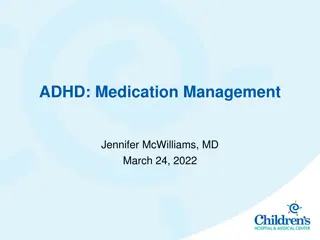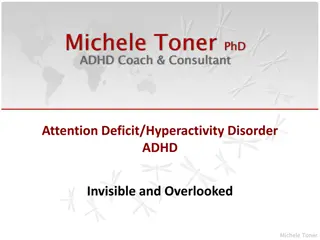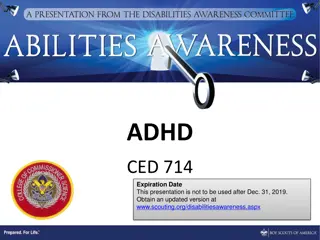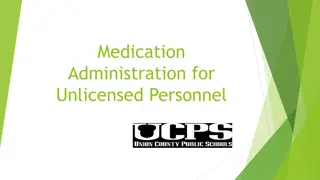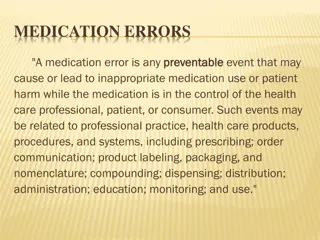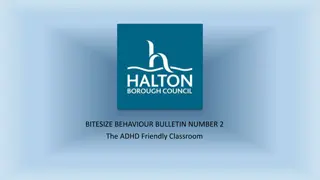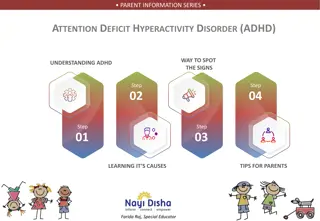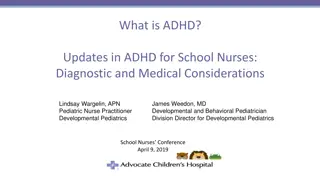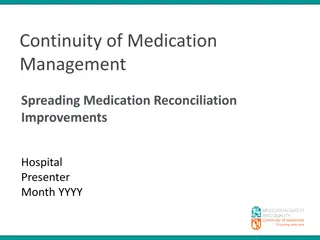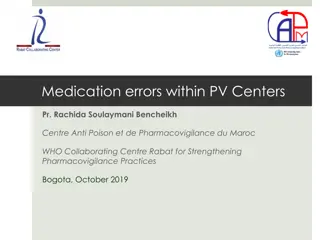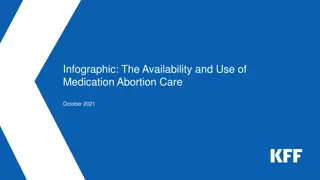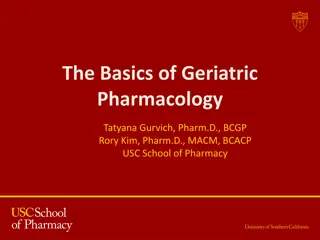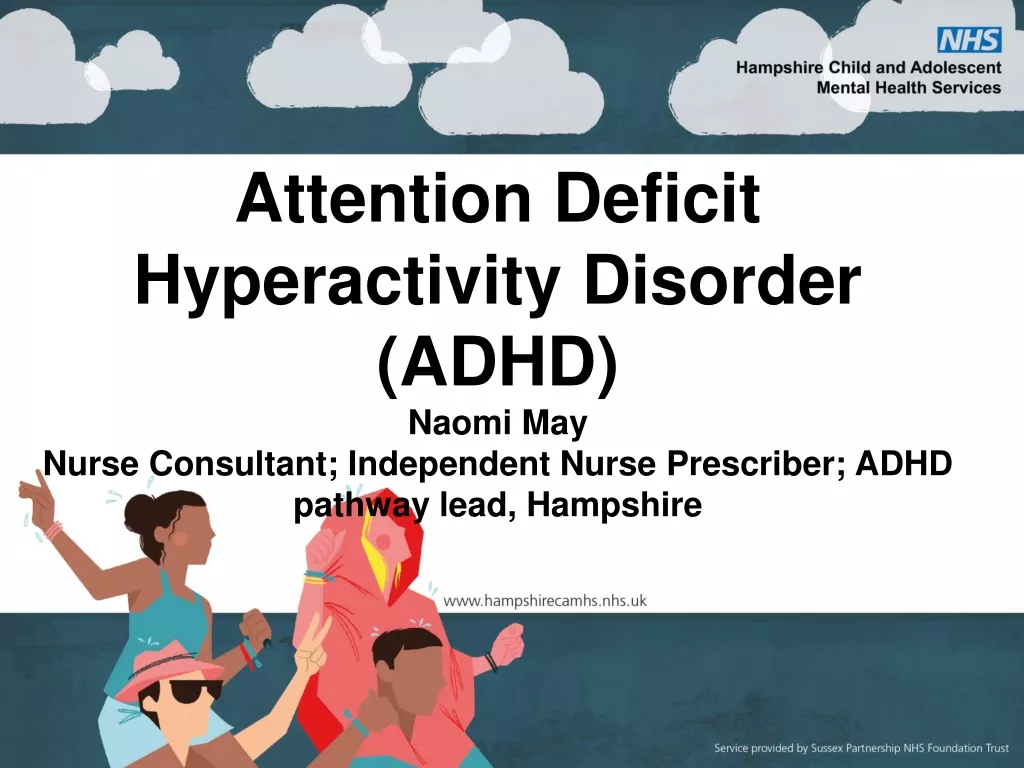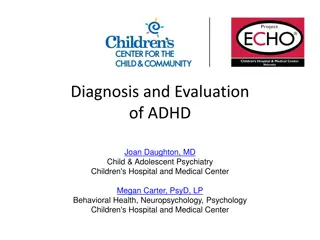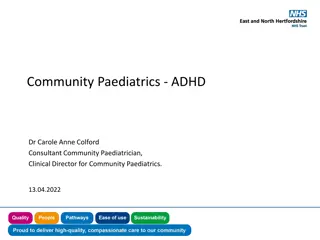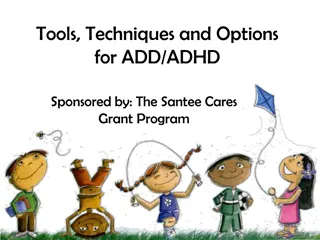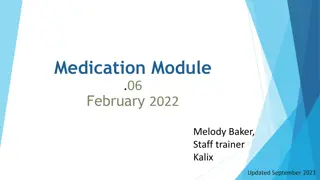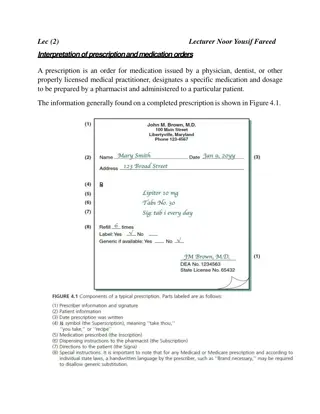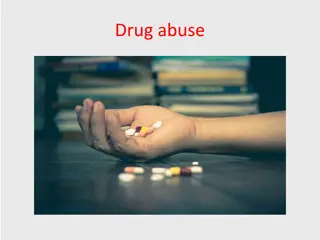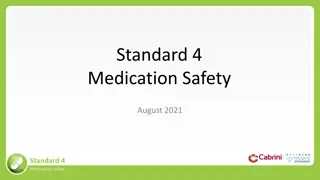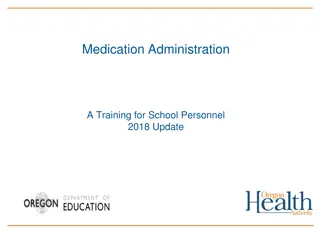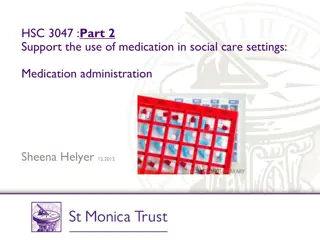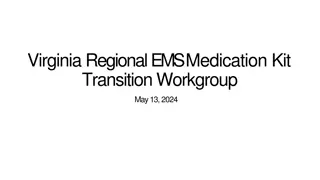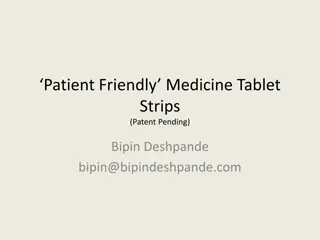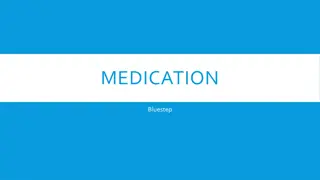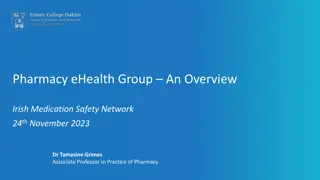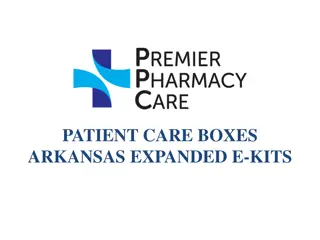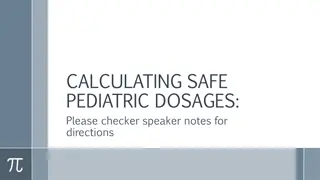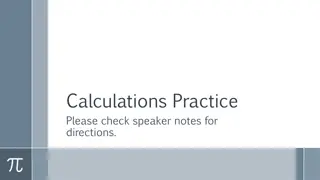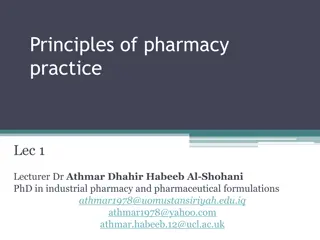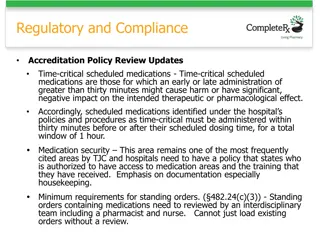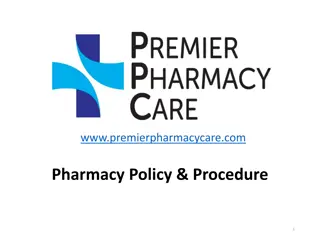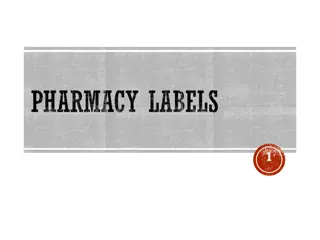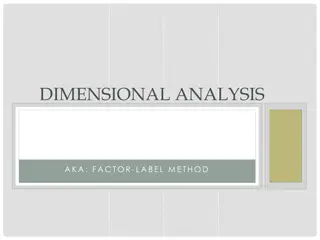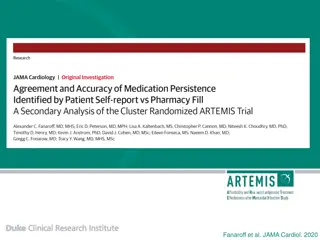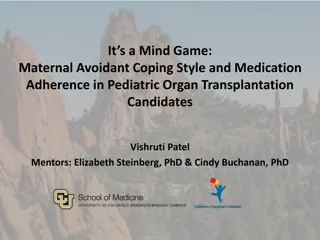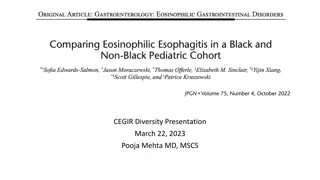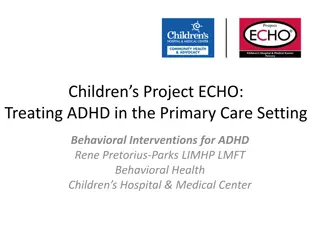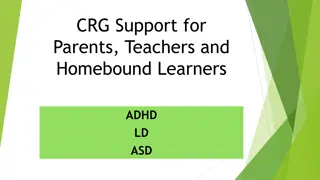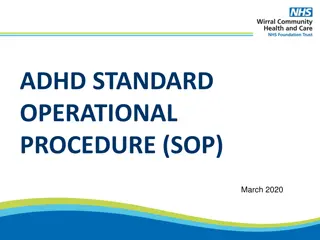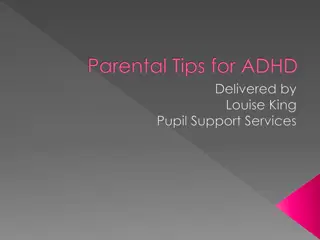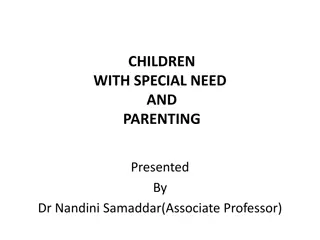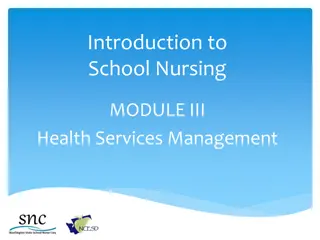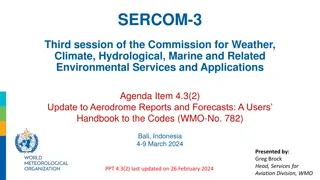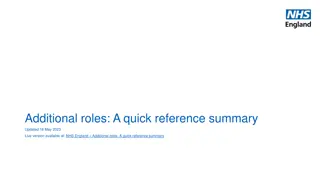Update on ADHD Medication Management
Problems with primary care physician (PCP) management for children with ADHD, emphasizing the importance of optimized treatment and ongoing feedback. Recommendations include stimulant medications as first-line treatment, behavior therapy as an adjunct, and consideration of multisite multimodal treatment studies for better outcomes.
Download Presentation

Please find below an Image/Link to download the presentation.
The content on the website is provided AS IS for your information and personal use only. It may not be sold, licensed, or shared on other websites without obtaining consent from the author. Download presentation by click this link. If you encounter any issues during the download, it is possible that the publisher has removed the file from their server.
E N D
Presentation Transcript
ADHD Medication Update Barbara J Howard, MD bhoward@chadis.com www.CHADIS.com
I & my spouse have the following financial relationship with the manufacturer of any commercial product and/or provider of commercial services discussed in this CME activity: CHADIS The Center for Promotion of Child Development through Primary Care and its for-profit subsidiary, Total Child Health, Inc. developed CHADIS, a web-based screening and decision support system. Dr. Howard is President and she and her spouse Dr. Sturner are members of the Board of Directors of the for-profit subsidiary, Total Child Health. Dr. Sturner is Director of the Center and both are members of its Board of Directors. They are paid consultants to both entities. The terms of the arrangement are being managed by The Johns Hopkins University in accordance with its conflict of interest policies. I do not intend to discuss an unapproved/investigational use of a commercial product/device in my presentation.
Problems with PCP Management Children managed by community physicians do significantly poorer than optimized treatment (MTA study) initially Optimal treatment requires ongoing feedback from home and school- rare Follow up visits are needed- only 53% provide them Families skeptical of medicine tend to discontinue even when child is correctly diagnosed and doing well Families may resort to alternative treatments
#3 Recommend stimulant medicine and/or behavior therapy Stimulants are first line. Behavior therapy may be helpful or an adjunct. Behavior therapy first for preschoolers. Stimulants improve core symptoms equally. 50% of children respond to one but not to another. Stimulants require no serologic, hematologic, or EKG monitoring. 3A: If one stimulant does not work at the highest feasible dose, try another. 3B: Find highest dose with no side effects or dose at which side effects are tolerable. 3C: If stimulants do not work/not tolerated, try non-stimulants with evidence-basis
Multisite Multimodal Treatment Study (MTA) 600 children (age 7 9) ADHD combined type 24 month outcomes Groups Medical management: monthly tailored Behavioral Therapy: 8 week summer; training; in- class aid, teacher consultation Combined Community standard: 67% meds mostly bid
MTA Results Medical management or combination therapy had better outcomes than behavioral therapy or community care Combined therapy was equal to medical for ADHD sx but for subgroups combined may be preferable Anxiety disorders; high levels of socio-economic and/or family stressors 8 year f/u: groups were equal (but no control group)
Caveats Many forms, esp since adderall became generic Many studies where authors were receiving money from pharma companies Studies usually short- often <12 weeks New forms may require preauthorization
Medication Choice: Stimulants MPH and DA are approximately equivalent in efficacy (75%) & side effects Some children respond better to one MPH dose = 0.3 - .5 mg/kg/dose; DA = 0.15- 0.25mg/kg/dose Ritalin SR is less effective and slower onset than short acting. Ritalin LA more reliable Long acting DA is more likely to cause sleep problems Dexedrine SR- 10-12 hours, greater anorexia, irritability? Adderall- 4-6 hours, Adderall XR 10-12 smoother Pemoline (Cylert) is not available because of liver toxicity->death
Medication - Dosing Short acting lasts 3 1/2 to 4 hours Children benefiting from school dosing usually can benefit from a 3rd dose Long acting now recommended Consider using a placebo trial- shared decisions With weekly parent and teacher ratings to establish objectivity Helps parents carefully sort out their fears from fact Helps establish an optimal dosage early Adjust q 3-7 days, visits q mo until stable then q 3 months for 1styear then q 6 months
CHADIS Graphic display of Vanderbilt
Other LA stimulants for ADHD MPH Concerta Focalin- d MPH- Short acting; dose; same effectiveness and side effects Focalin XR (5,10,20)- 10-12 hours, same side effects Methylin liquid 5 or 10/5cc short acting Metadate CD- MPH, 6 hours, can sprinkle Ritalin LA- MPH, 8-10 hours Daytrana or MTS or MethyPatch Quillivant and Quillichew DA Vyvanse = Slow release mixed salts of amphetamine Procentra = Liquid Dexedrine 5 mg/5 cc
Methylphenidate Transdermal System or Daytrana or MethyPatch Takes 2 hours for effect, remove at 9 hours, lasts 12 Signif. effective vs placebo Potential for sensitization to methylphenidate due to topical route MTS vs Concerta: Insomnia 13% vs 8%; anorexia 26% vs 19% 12.5 cm = 18 mg Concerta, 18.75 cm = 27 mg Concerta, 25 cm = 36 mg Concerta, 37.5 cm = 54 mg Concerta
Procentra Dextroamphetamine 5 mg/5 ml Lasts 4-8 hours; T1/2 11.75 hours. Bubble gum flavor. 3 years + 3-5 years start with 2.5 mg, 6+yrs start 5 mg Max. 40 mg
Zenzedi (IR) Dextroamphetamine IR tablet Dose 2.5, 5, 7.5, 10, 15, 20, 30 Ages 3-16 3-5 yrs give 2.5 and increase; 6yrs+ 5 mg and increase; max 40 Peaks at 3 hours, second dose at 4-6 hours
Whats New? ODT Oral dissolving tablet On tongue; do not chew; do not push through foil or touch with wet hands;
Cotempla XR-ODT Long-acting oral dissolving methylphenidate. Signif diff from placebo 1-12 hours 8.6 (10 mg MPH ER), 17.3 (20), 25.9 (30) mg 25% IR, 75% ER. Do not chew or crush.Grape. Ages 6-17 Start at 17.3, increase weekly, max 51.8 mg Call 844-423-9369 for availability
Adzenys XR -ODT Orally disintegrating mixed salts amphetamine 5 hours maximum concentration if fasting; 7 hours with food and 19% reduction in maximum concentration. Age 6+ 50% IR, 50% ER 3.1, 6.3, 9.4, 12.5, 15.7, 18.8 mg Orange Start at 6.3 and increase wkly, Max 18.8 for 6-12 yr olds; 12.5 for 13-17 18.8 = 30 mg Adderall XR Exactly the same pharmacodynamics as Adderall XR Call 844-423-9369 for availability
Aptensio XR capsules Methylphenidate extended release 6 years+ IR 40%, controlled release layer 60% 10 mg, 15, 20, 30, 40, 50, 60 mg equivalent to 8.6 mg, 13.0, 17.3, 25.9, 34.6, 43.2, or 51.9 of methylphenidate free base. Start at 10 mg, increase wkly, max 60. Only 20 & 40 mg better than placebo. Can sprinkle, do not chew or store. Avoid fat.
Dyanavel XR Extended release amphetamine liquid drug is bound to the ion exchange resin; IR and ER. ER is coated with an aqueous, pH-independent polymer. 2.5 mg/1 cc (equals 4 mg Adderall) Start 2.5 to 5 mg up to 20 mg Signif diff from placebo 1-13 hours. Bubble gum flavor. Shake well. Best prior to eating. Food (especially fat) delays onset by one hour Alcohol causes dumping. Antacids inc. level. Ascorbic acid decreases.
Mydayis capsules Mixed Amphetamine salts (with 3:1 dextro to levo base) 3 different beads releasing at different ph's extending duration to 16 hours (starts 2 4 hrs); Hint- like Adderall XR but 3 types of beads and lasts longer up to 16 hours Approved only >12 years so far
Non-stimulants for ADHD Atomoxetine Intuniv = guanfacine extended release Clonicel = long acting clonidine (KapVay)
Atomoxetine (Strattera) Norepinephrine reuptake inhibitor- not category II CYP2D6 metabolized, T1/2 5.2 h Signif better than placebo in child & adult Side effects: anorexia 14%, N/V/D 12-15%, dizziness, fatigue 9%, mood swings 5% SUICIDAL Possible inc or dec BP, inc pulse, allergic rash Recent reports liver abnormalities and failure Contraindicated near MAO inhibitors 0.5mg/kg->2.0 q 3 d max 100mg div qd-bid. Less with paroxetine or fluoxetine Takes 4-6 or even 9 weeks to max effectiveness
Intuniv FDA approved 6/07 Selective agonist for alpha-2A-receptors in the prefrontal cortex Nonstimulant Monotherapy or adjunct Once daily long acting; am or pm Ages 6 to 17 years 1 mg to 4 mg daily Better than placebo in 2 double blind trials Main side effect is sedation, hypotension Takes 2-4 weeks for effect; taper to stop
Other Nonstimulants Clonidine: 4-5 microgram/kg/day or Guanfacine (Tenex) long acting (Kapvay); esp for aggression and when sedation HS needed; cvs concerns Bupropion
Bupropion (Wellbutrin) 1.Antidepressant with stimulant action (beta noradrenergic receptors and prefrontal lobe) 2.Significant effect on ADHD but less effect size than first line stimulants 3.Better than nicotine patch for smoking cessation ("Zyban") 4.Dosage: 3-6 mg/kg (</=300/day); 75, 100, & 150 mg SR 5. Side-effects (especially if increase fast): Decreased seizure threshold (rate = .06%), agitation, insomnia
Vayarin (Omega -3) Eicosapentaenoic acid (EPA) 21.5 mg Docosahexaenoic acid (DHA) 8.5 mg Phosphatidylserine (PS) 75 mg 60% taking 3 months noticed some benefit. Only 40% stayed with it (Nguyen et al., 2014). $60/mo no insurance coverage 200 randomized double-blind, placebo-controlled trial 15 weeks on 300 mg PS, 86 mg EPA and 34 mg DHA had significant reduction Connors parent assessment.
Stimulant Side Effects Common: anorexia, headache, stomach aches, skin picking, tics. Fatigue and depression if stop higher dose. Uncommon: Psychosis Glaucoma, blurred vision Priapism Raynaud s syndrome Seizures Abuse Serotonin Syndrome in combination c other meds
Serotonin Syndrome Amphetamines + other substance Symptoms include agitation, hallucinations, coma or other changes in mental status, problems controlling your movements or muscle twitching, fast heartbeat, high or low blood pressure, sweating or fever, nausea or vomiting, diarrhea, and muscle stiffness or tightness. Occurs with MAOIs, SSRIs, SNRIs, triptans, tricyclics, fentanyl, lithium, tramadol, tryptophan, buspirone, and St. John s Wort
Stimulants and CV Risk FDA reports showed: 25 patients (19 who were 18 years and younger) taking stimulants had suddenly died. 54 more patients on these pills had unusual heartbeats, heart attacks, or strokes. Some had preexisting heart problems, some were taking other pills, including cocaine. AAP advises continuing current practice FDA- no black box warning Prudent to avoid use in structural heart disease, arrythmia, ? if FH sudden cardiac death
Managing Side Effects Appetite - 4th meal at bedtime Abdominal pain disappears in 3 wks; try slow acting medication; ?bowel urgency; give with food Headache disappears in 3 wks; try slow acting, use 7 days/wk Growth 1 kg, 1-2 cm; mostly nutrition related; reversible with drug holidays if needed Tics - mostly due to comorbidity, may have less tics with stimulants; 0.5% chance of a persistent problem; try lower dose Irritability- change family of meds, use another dose in pm
Sleep problems in ADHD 85% of children with ADHD have sleep problems before using meds Sleep debt makes ADHD and comorbid conditions worse Mostly trouble falling asleep but also restless Consider OSA if snore, bipolar if up for hours in the middle of the night Start with routine bedtime, back rub, milk, white noise Meds prn: evening stimulant dose, melatonin 1-8 mg, Clonidine 0.05-0.1 mg., guanfacine up to 1 mg
For CME 2 things you will do differently or think differently about as a result of this webinar Send to bhoward@chadis.com
Selected References AACAP, Practice Parameter for the Assessment and Treatment of Children and Adolescents With Attention- Deficit/Hyperactivity Disorder. J. Am. Acad. Child Adolesc. Psychiatry, 2007;46(7):894-921. October 16, 2011, doi: 10.1542/peds.2011-2654
Appendix to ADHD Clinical Practice Guideline: Implementing the Key Action Statements An Algorithm and Explanation for Process of Care for the Evaluation, Diagnosis, Treatment and Monitoring of ADHD in Children and Adolescents (http:/ / pediatrics.aappublications.org/ content/ suppl/ 2011/ 10/ 11/ peds.2011-2654.DC1/ zpe611117822p.pdf)
AAP, Caring for Children with ADHD: A Resource Toolkit for Clinicians, 2nd Edit. 2011. Item #: CD0063 ISBN 13: 978-1-58110-578-0 AAP, 2011. ADHD: Clinical Practice Guideline for the Diagnosis, Evaluation, and Treatment of Attention- Deficit/Hyperactivity Disorder in Children and Adolescents. Pediatrics Vol. 128 No. 5 November 1, 2011 pp. 1007 -1022
AAP, 2001. Clinical Practice Guideline: Treatment of the School-Aged Child With Attention- Deficit/Hyperactivity Disorder. Pediatrics 108 (4) 1033
American Academy of Pediatrics, Committee on Quality Improvement and Subcommittee on Attention- Deficit/Hyperactivity Disorder. 2000. Diagnosis and evaluation of the child with attention- deficit/hyperactivity disorder. Pediatrics. 105:1158 1170
Atkinson M, Hollis C. 2010. NICE guideline: attention deficit hyperactivity disorder. Arch Dis Child Educ Pract Ed 2010;95:24 27 Epstein JN, Langberg JM, Lichtenstein PK, Altaye M, Brinkman WB, House K, Stark LJ. 2010. Attention- Deficit/Hyperactivity Disorder Outcomes for Children Treated in Community-Based Pediatric Settings. Arch Pediatr Adolesc Med. 2010;164(2):160-165
Wolraich ML, Bard DE, Stein MT, Rushton JL, OConnor KG, 2010. Pediatricians Attitudes and Practices on ADHD Before and After the Development of ADHD Pediatric Practice Guidelines. J. of Att. Dis. 2010; 13(6) 563-572
References: Barkley, R. A. Attention Deficit Hyperactivity Disorder: A handbook for diagnosis and treatment. New York: Guilford Press, 72 Spring St., New York, NY, 1990. Culbert TP, Banez, GA, Reiff, MI. Children who have Attentional Disorders: Interventions. Pediatrics in Review 15 (1), 5-14. 1994 Diller, L. H., Running on Ritalin, Bantam Books, New York, NY, 1998.
Gorski P (Ed) 2002, Supplement, The Diagnosis and Treatment of ADHD in Early Childhood: Evidence Based Controversies and Implications of Practice and Policy, J Dev Beh Ped 23(1S)
Greenhill, L. L., Attention-Deficit Hyperactivity Disorder: The Stimulants. In Riddle, MA, (Ed), Pediatric Psychopharmacology I Child and Adolescent Psychiatric Clinics of North America, January. 123. 4:1, Saunders, Phila, PA. 1995 Papolos D and Papolos J: The Bipolar Child. Broadway Books, NY, 1999
Reiff MI, Banez, GA, Culbert TP. Children Who Have Attentional Disorders: Diagnosis and Evaluation. Pediatrics in Review. 14. 455-469. 1993. Sturner RA, 2005, Attention Deficit Disorder, In The Child Health and Development Interactive System, www.CHADIS.com
Wolraich, M (Edit.), 1996, The Classification of Child and Adolescent Mental Diagnoses in Primary care. Diagnostic and Statistical Manual for Primary Care (DSM-PC), Child and Adolescent Version, American Academy of Pediatrics www.nichq.org for Vanderbilt checklist
Omega-3 Bloch, M., & Qawasmi, A. (2011). Omega-3 fatty acid supplementation for the treatment of children with attention-deficit/hyperactivity disorder symptomatology: Systematic review and meta- analysis. Journal of the American Academy of Child and Adolescent Psychiatry, 50, 991-1000. Manor, I., et al. (2012). The effect of phosphatidylserine containing omega3 fatty-acids on attention-deficit hyperactivity disorder symptoms in children: A double-blind placebo- controlled trial, followed by an open-label extension. European Psychiatry, 27, 335-342.


